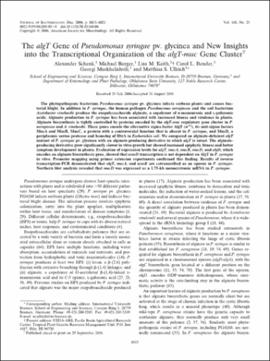| dc.contributor.author | Schenk, Alexander | |
| dc.contributor.author | Berger, Michael | |
| dc.contributor.author | Keith, Lisa M. | |
| dc.contributor.author | Bender, Carol L. | |
| dc.contributor.author | Muskhelishvili, Georgi | |
| dc.contributor.author | Ullrich, Matthias S. | |
| dc.date.accessioned | 2015-10-16T20:47:43Z | |
| dc.date.available | 2015-10-16T20:47:43Z | |
| dc.date.issued | 2006-12 | |
| dc.identifier | okds_Bender_JB_2006-12.pdf | |
| dc.identifier.citation | Schenk, A., Berger, M., Keith, L. M., Bender, C. L., Muskhelishvili, G., & Ullrich, M. S. (2006). The algT gene of Pseudomonas syringae pv. glycinea and new insights into the transcriptional organization of the algT-muc gene cluster. Journal of Bacteriology, 188(23), 8013-8021. https://doi.org/10.1128/JB.01160-06 | |
| dc.identifier.uri | https://hdl.handle.net/11244/19775 | |
| dc.description.abstract | The phytopathogenic bacterium Pseudomonas syringae pv. glycinea infects soybean plants and causes bacterial blight. In addition to P. syringae, the human pathogen Pseudomonas aeruginosa and the soil bacterium Azotobacter vinelandii produce the exopolysaccharide alginate, a copolymer of D-mannuronic and L-guluronic acids. Alginate production in P. syringae has been associated with increased fitness and virulence in planta. Alginate biosynthesis is tightly controlled by proteins encoded by the algT-muc regulatory gene cluster in P. aeruginosa and A. vinelandii. These genes encode the alternative sigma factor AlgT (sigma^22), its anti-sigma factors MucA and MucB, MucC, a protein with a controversial function that is absent in P. syringae, and MucD, a periplasmic serine protease and homolog of HtrA in Escherichia coli. We compared an alginate-deficient algT mutant of P. syringae pv. glycinea with an alginate-producing derivative in which algT is intact. The alginateproducing derivative grew significantly slower in vitro growth but showed increased epiphytic fitness and better symptom development in planta. Evaluation of expression levels for algT, mucA, mucB, mucD, and algD, which encodes an alginate biosynthesis gene, showed that mucD transcription is not dependent on AlgT in P. syringae in vitro. Promoter mapping using primer extension experiments confirmed this finding. Results of reverse transcription-PCR demonstrated that algT, mucA, and mucB are cotranscribed as an operon in P. syringae. Northern blot analysis revealed that mucD was expressed as a 1.75-kb monocistronic mRNA in P. syringae. | |
| dc.format | application/pdf | |
| dc.language | en_US | |
| dc.publisher | American Society for Microbiology | |
| dc.rights | This material has been previously published. In the Oklahoma State University Library's institutional repository this version is made available through the open access principles and the terms of agreement/consent between the author(s) and the publisher. The permission policy on the use, reproduction or distribution of the material falls under fair use for educational, scholarship, and research purposes. Contact Digital Resources and Discovery Services at lib-dls@okstate.edu or 405-744-9161 for further information. | |
| dc.title | AlgT gene of Pseudomonas syringae pv. glycinea and new insights into the transcriptional organization of the algT-muc gene cluster | |
| osu.filename | okds_Bender_JB_2006-12.pdf | |
| dc.description.peerreview | Peer reviewed | |
| dc.identifier.doi | 10.1128/JB.01160-06 | |
| dc.description.department | Entomology and Plant Pathology | |
| dc.type.genre | Article | |
| dc.type.material | Text | |
